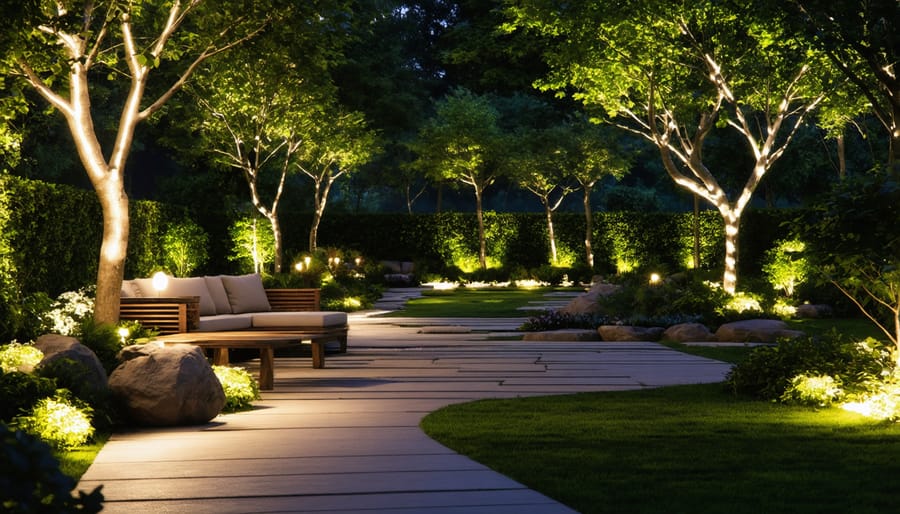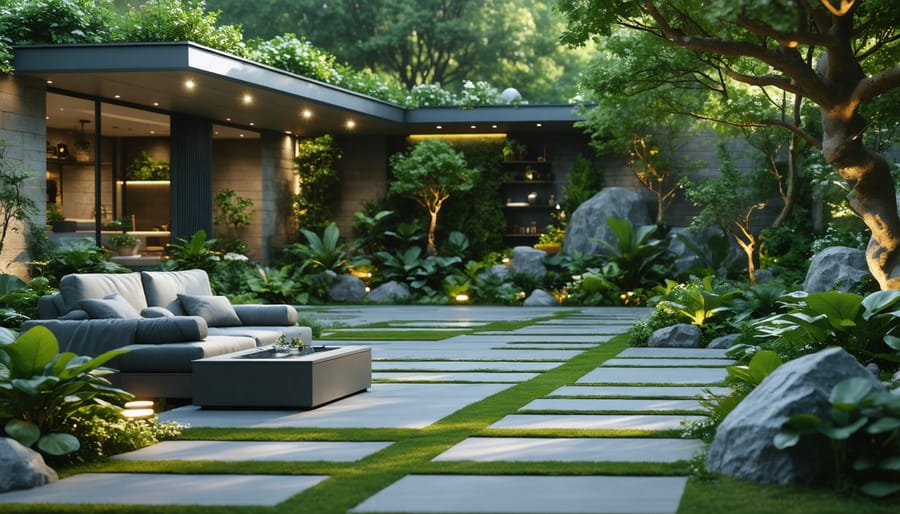Transform your garden into a magical nighttime retreat with strategic lighting that illuminates paths, highlights focal points, and creates enchanting shadows. Layer your outdoor lighting using three key elements: ground-level path lights to guide movement, accent spotlights to transform your outdoor space, and ambient fixtures that cast a warm, welcoming glow. Modern solar-powered LEDs and smart lighting systems now make it possible to create professional-quality garden illumination while maintaining energy efficiency and reducing environmental impact. Whether you’re hosting evening gatherings or simply enjoying quiet moments under the stars, thoughtful garden lighting design elevates your outdoor living experience from ordinary to extraordinary. By combining practical safety features with artistic elements, you’ll create an outdoor sanctuary that extends your living space well beyond sunset.

Creating Layers of Light in Your Garden
Ambient Lighting for Overall Illumination
Ambient lighting forms the foundation of any well-designed garden lighting scheme, providing gentle, overall illumination that creates a welcoming atmosphere. Path lights are essential elements, guiding visitors safely through your garden while casting a warm glow across ground-level plants. Consider installing them at regular intervals, roughly 6-8 feet apart, to ensure consistent lighting without creating a runway effect.
Post lights serve as anchor points in your garden design, offering both practical illumination and architectural interest. Place them strategically near entrance ways, pergolas, or at the corners of distinct garden zones. Modern solar-powered options make installation easier than ever, while traditional wired fixtures provide reliable illumination regardless of weather conditions.
For comprehensive garden illumination, layer your lighting by combining different fixtures. Low-voltage wash lights can softly illuminate walls and fences, while carefully placed spotlights can provide gentle overhead illumination when mounted in trees. Remember that less is often more with ambient lighting – aim for a subtle, moonlit effect rather than harsh, artificial brightness. This approach not only creates a more natural ambiance but also respects local wildlife and reduces light pollution.
Task Lighting for Functional Areas
Task lighting is essential for creating safe and functional outdoor spaces that you can enjoy well into the evening. For patios, consider installing adjustable spotlights or wall-mounted sconces that provide focused illumination for dining and entertaining. A mix of overhead string lights and table lamps creates a warm, inviting atmosphere while ensuring everyone can see their food and companions clearly.
Outdoor cooking areas require bright, practical lighting to ensure safe food preparation. Install weather-resistant LED strips under countertops or mount directional lights above your grill station. Remember to position lights so they won’t cast shadows on your cooking surface or create glare in your eyes while you work.
Steps and walkways deserve special attention for safety. Line each step with low-voltage LED strip lights or install riser lights to clearly mark elevation changes. For maximum visibility, place lights at consistent intervals and ensure they’re positioned to illuminate the full width of each step. Motion sensors can be particularly useful here, automatically lighting the way as you approach.
Accent Lighting for Drama
Create stunning drama in your garden with strategic accent lighting techniques that highlight your landscape’s best features. Uplighting places fixtures at ground level, directing light upward to showcase tree canopies, architectural elements, and textured walls. This technique creates dramatic shadows and depth, making even modest garden features appear grand and theatrical.
Downlighting, mounted in trees or on structures, mimics natural moonlight as it filters through branches and leaves. This gentle illumination creates beautiful patterns on pathways and patios while providing practical visibility. For added intrigue, try grazing techniques, where lights are positioned close to walls or fences to emphasize interesting textures and materials.
Feature highlighting draws attention to garden focal points like sculptures, water features, or prized plants. Position lights at different angles to experiment with shadows and create layered lighting effects. Remember to use warm white lights for natural elements and cooler tones for modern architectural features to enhance their unique characteristics.
Sustainable and Smart Lighting Solutions
Solar-Powered Options
Solar-powered lighting has revolutionized the way we illuminate our gardens, offering sustainable and cost-effective eco-friendly garden solutions that are both practical and beautiful. These fixtures harness the sun’s energy during the day and automatically illuminate your outdoor space as darkness falls, requiring no electrical connections or ongoing energy costs.
Modern solar lights come in an impressive variety of styles, from classic path lights and elegant string lights to contemporary bollards and decorative lanterns. Many feature advanced photocell technology that automatically adjusts brightness based on available light, ensuring optimal performance throughout the year.
For best results, position solar lights where they’ll receive maximum sunlight during the day – typically in open areas away from dense foliage or building shadows. Consider using a mix of lighting types: stake lights for pathways, hanging lanterns for trees, and mounted lights for walls or fences. Most solar lights now include long-lasting LED bulbs and high-capacity batteries that provide reliable illumination even during cloudy periods.
The latest solar lighting options also include smart features like motion sensors and remote controls, making them increasingly sophisticated while remaining wonderfully simple to install and maintain. They’re perfect for creating ambient lighting without increasing your carbon footprint or energy bills.
Smart Control Systems
Modern garden lighting has become incredibly smart, making it easier than ever to create the perfect outdoor ambiance. Smart control systems let you manage your entire garden lighting setup right from your smartphone or tablet. With these systems, you can adjust brightness levels, set automated schedules, and even change colors with just a few taps.
One of the most practical features is motion detection, which automatically illuminates pathways and entrance areas when someone approaches. This not only enhances security but also helps conserve energy. Many systems also include astronomical timers that adjust to seasonal sunset and sunrise times, ensuring your lights come on at exactly the right moment throughout the year.
Weather-responsive controls are another game-changer. These smart systems can automatically adjust your lighting based on weather conditions, dimming during clear nights and brightening during foggy evenings. Some advanced systems even integrate with your home automation setup, allowing you to create coordinated lighting scenes for different occasions – from quiet evening gatherings to lively outdoor parties.
For the eco-conscious gardener, many smart systems now include energy monitoring features that help you track and optimize power usage. They can even learn your patterns and suggest more efficient lighting schedules, making your garden both beautiful and environmentally friendly.

Creative Lighting Ideas for Different Garden Styles
Contemporary Gardens
Contemporary outdoor lighting embraces clean lines and minimalist aesthetics, perfectly complementing modern garden designs. LED strip lighting has become a go-to choice, offering sleek illumination along pathways and architectural features while consuming minimal energy. Consider installing recessed ground lights that sit flush with your paving, creating an understated yet dramatic effect that doesn’t interrupt the clean visual flow of your space.
Geometric lighting fixtures in metallic finishes add sophisticated touches to contemporary gardens. Think cube-shaped path lights or cylindrical bollards in brushed steel or matte black. For a truly modern touch, smart lighting systems allow you to control brightness and color temperature from your phone, creating different moods for various occasions.
Wall-mounted downlights with sharp angles complement modern architecture while providing practical illumination for outdoor dining areas. Float LED orbs in water features or position color-changing spotlights beneath structural plants for an artistic evening display that maintains the minimalist aesthetic while adding visual interest to your nighttime garden.
Cottage Gardens
Cottage gardens call for a gentler, more romantic approach to lighting that enhances their natural charm and whimsy. Soft, warm white lights nestled among climbing roses and winding pathways create an enchanting atmosphere that feels both magical and welcoming. Consider placing vintage-style lanterns along garden paths, their warm glow complementing the informal planting style that cottage gardens are known for.
Solar-powered copper wire lights woven through climbing plants and arbors add a subtle twinkle without overwhelming the space’s natural beauty. These delicate strands create a starlit effect that’s particularly enchanting during summer evenings spent outdoors. For a traditional touch, consider installing wall-mounted coach lights near seating areas or entranceways, choosing fixtures with an aged brass or iron finish to maintain that timeless cottage aesthetic.
Mason jars filled with battery-operated fairy lights make charming temporary lighting solutions for garden parties, while strategically placed uplights can softly illuminate signature plants like hollyhocks and foxgloves, creating gentle shadows that dance through the evening air. Remember, the key is to keep the lighting subtle and layered, allowing the garden’s natural beauty to remain the star of the show.
Japanese-Inspired Gardens
Japanese-inspired gardens call for a delicate touch when it comes to lighting, embracing the zen principle of “less is more.” Traditional paper lanterns, or chochin, create a soft, welcoming glow that perfectly complements the peaceful atmosphere of these spaces. Position them along stone pathways or near water features to cast gentle reflections that enhance the meditative qualities of your garden.
Low-voltage LED uplights work beautifully to illuminate specimen trees, particularly maples and cherry blossoms, creating dramatic shadows that dance on nearby walls or fencing. Consider placing small, weatherproof spotlights at the base of carefully pruned bonsai or cloud-pruned trees to highlight their sculptural forms after dark.
For rock gardens and gravel areas, consider recessed path lights that sit flush with the ground, maintaining the clean lines and minimalist aesthetic. Near meditation areas or seating spaces, stone lanterns provide both practical illumination and authentic decorative elements that have been used in Japanese gardens for centuries.
Water features can be subtly lit from below with submersible lights, creating a mesmerizing effect as the light plays on rippling surfaces. Remember to keep the overall lighting scheme subtle and balanced, allowing dark spaces to exist alongside the illuminated areas – this contrast is essential to the Japanese garden aesthetic.

Mediterranean Gardens
Mediterranean gardens come alive at night with warm, inviting lighting that captures the essence of alfresco living. Start with strategically placed copper lanterns and iron wall sconces that cast a golden glow reminiscent of Mediterranean sunsets. These fixtures not only provide illumination but also serve as artistic elements during daylight hours.
Layer your lighting with strings of Edison bulbs draped between olive trees or pergolas, creating an enchanting canopy that bathes dining areas in a soft, ambient light. Terra cotta pot lights placed among herbs and lavender beds add warmth while highlighting fragrant plantings typical of Mediterranean gardens.
Consider installing low-voltage uplights near architectural features like stone walls or water fountains. The warm light bouncing off textured surfaces creates dramatic shadows and depth, enhancing the romantic atmosphere. Solar-powered pathway markers in brass or copper finishes guide guests through garden paths while maintaining the Mediterranean aesthetic.
For a final touch, incorporate traditional oil lamps or LED alternatives on dining tables and seating areas. These portable lights create intimate zones perfect for evening gatherings and maintain the authentic Mediterranean charm while being energy-efficient.
Safety and Maintenance Tips
Installation Best Practices
When installing garden lighting, safety should always be your top priority. Start by mapping out your lighting plan on paper, marking cable routes and power source locations. Always use outdoor-rated fixtures and cables designed to withstand the elements, and ensure all electrical connections are properly waterproofed.
For optimal installation, bury cables at least 18 inches deep and use conduit in high-traffic areas. Position transformers in covered areas, keeping them elevated and away from standing water. It’s wise to install lights in phases, testing each section before moving forward to ensure everything works as planned.
Consider installing motion sensors or timers to maximize energy efficiency. When mounting lights, use sturdy stakes or bases that won’t shift with soil movement or weather changes. For tree-mounted fixtures, use adjustable straps that allow for tree growth rather than permanent fasteners.
Remember to check local building codes and regulations before starting your installation. While many lighting projects can be DIY, don’t hesitate to consult a professional electrician for complex setups or if you’re unsure about any aspect of the installation. This investment in proper installation will ensure your garden lighting remains safe and beautiful for years to come.
Seasonal Maintenance
Regular maintenance ensures your garden lighting system remains beautiful and functional throughout the changing seasons. Like other low-maintenance garden features, proper care will extend the life of your lighting investments.
In spring, inspect all fixtures for winter damage and clean them thoroughly to remove debris and dirt buildup. Check wiring connections and replace any damaged cables. It’s also a good time to adjust timing systems as daylight hours increase.
Summer maintenance focuses on keeping fixtures clear of rapidly growing foliage. Trim back plants that might obstruct light paths and clean solar panels regularly to maintain optimal charging. Consider repositioning lights to accommodate full summer growth.
Fall requires extra attention to falling leaves and debris. Clear them regularly to prevent moisture buildup and potential short circuits. Test all connections before winter and apply weatherproof covers where needed.
During winter, keep snow and ice from accumulating on fixtures and solar panels. Adjust timers to account for shorter days, and consider reducing usage during severe weather to protect system components.
Transforming your garden with thoughtful lighting design is an exciting journey that can completely revolutionize your outdoor space. From creating cozy conversation areas to highlighting your favorite plants, the right lighting choices can turn your garden into a magical nighttime retreat. Remember to start with a solid plan, considering both functionality and ambiance. Layer your lighting by combining different techniques – path lights for safety, uplighting for drama, and ambient lighting for atmosphere. Don’t forget to embrace sustainable options like solar-powered fixtures and LED bulbs, which not only reduce your energy costs but also help protect our environment.
Whether you’re starting small with a few strategic spotlights or planning a comprehensive lighting scheme, the key is to begin with one area and gradually expand your design. Take time to experiment with placement and intensity levels, and don’t be afraid to adjust as needed. Your garden lighting project is a creative expression that evolves with your space and preferences.
Ready to get started? The perfect time is now – imagine stepping into your beautifully lit garden tomorrow evening, enjoying every corner of your outdoor sanctuary long after sunset.




